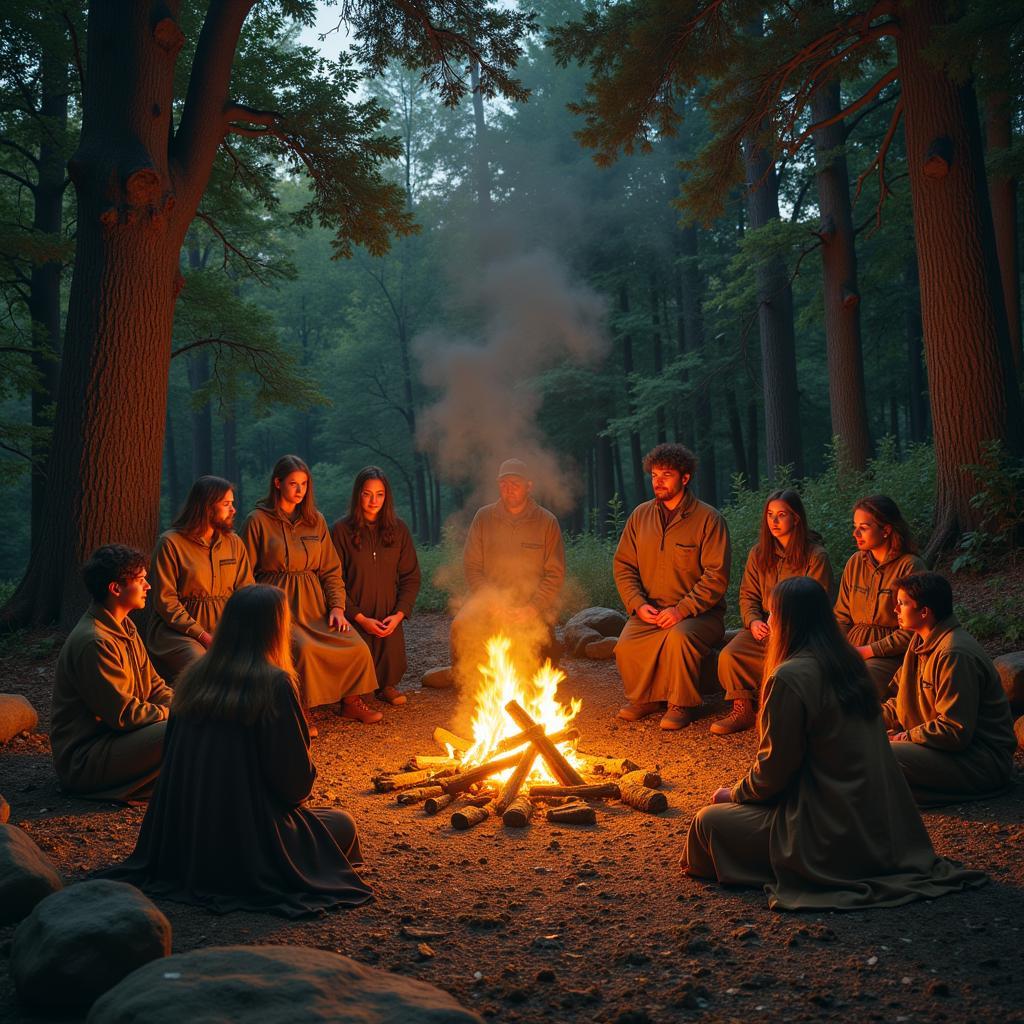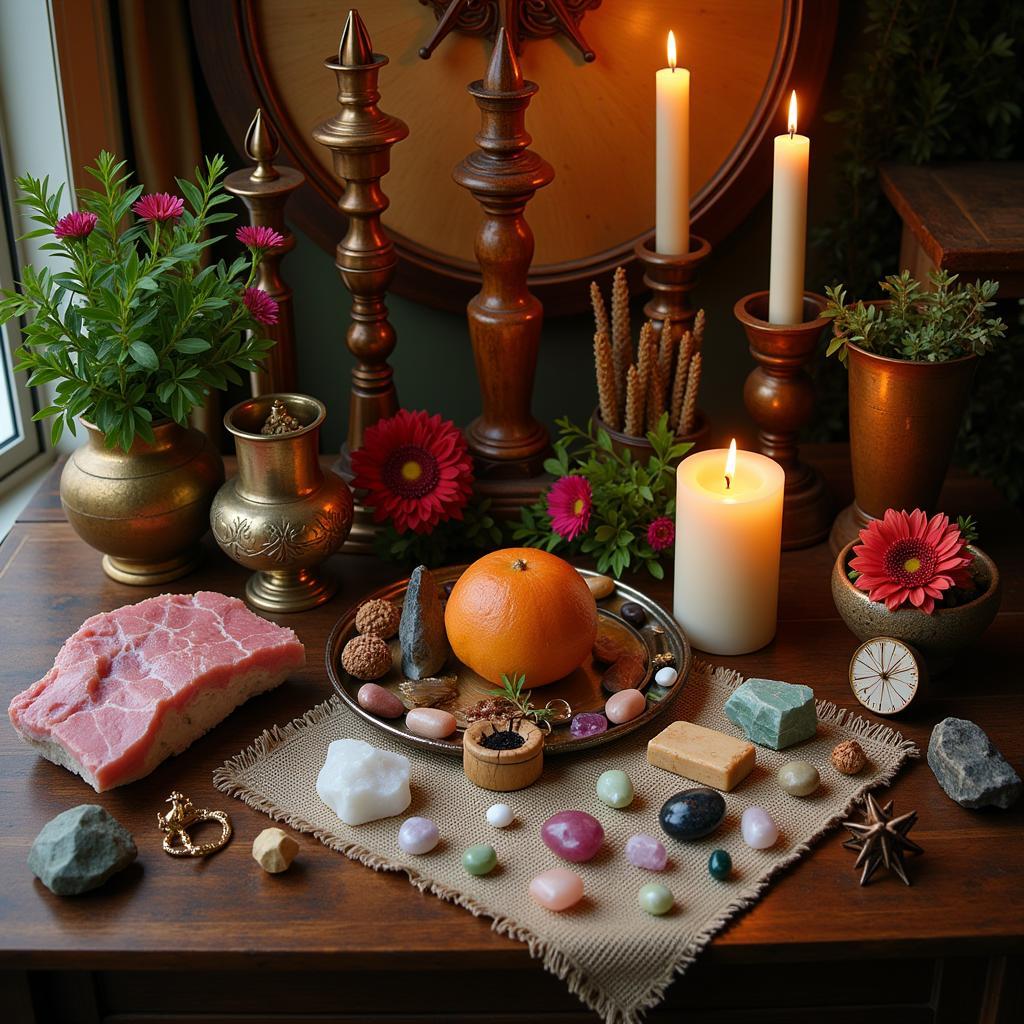The Druid Wheel Of The Year is a powerful symbol and framework that represents the cyclical nature of life, death, and rebirth as observed by modern Druids and other Pagan traditions. It’s a journey through eight solar festivals, each marking a significant turning point in the Earth’s journey around the sun. These festivals offer opportunities for connection with nature, spiritual growth, and celebration of the interconnectedness of all things.
Delving into the Eight Sabbats of the Wheel of the Year
The Wheel of the Year is divided into eight sabbats, each holding its own unique significance and corresponding to specific points in the solar calendar. These eight festivals are interwoven with the natural world, reflecting the changing seasons and the ebb and flow of life.
Samhain (October 31st)
Samhain marks the end of the harvest season and the beginning of the dark half of the year. It’s a time of reflection, remembrance, and honoring ancestors. This festival is also associated with the thinning of the veil between worlds, making it a potent time for divination and spiritual connection.
Yule (Winter Solstice, around December 21st)
Yule celebrates the return of the sun after the longest night of the year. It signifies rebirth, hope, and the promise of new beginnings. This is a time for celebrating the light and looking forward to the lengthening days.
Imbolc (February 2nd)
Imbolc marks the stirring of spring and the first signs of new life emerging from the earth. It’s a time for purification, cleansing, and preparing for the coming growth. This festival is associated with the goddess Brigid and her association with fire, healing, and poetry.
Ostara (Spring Equinox, around March 20th)
Ostara celebrates the arrival of spring and the balance between light and darkness. It’s a time of fertility, growth, and new beginnings. This festival is associated with eggs, rabbits, and the awakening of nature.
Beltane (May 1st)
Beltane is a celebration of life, fertility, and the union of the God and Goddess. It’s a time of joy, passion, and celebrating the abundance of nature. This festival is often associated with maypoles, bonfires, and celebrating the blossoming of life.
Litha (Summer Solstice, around June 21st)
Litha marks the peak of summer and the longest day of the year. It’s a time for celebrating the sun’s power, abundance, and the fullness of life. This festival is often associated with bonfires, feasting, and celebrating the warmth and light.
Lughnasadh (August 1st)
Lughnasadh is the first harvest festival, celebrating the abundance of the earth and the beginning of the harvest season. It’s a time of gratitude, thanksgiving, and preparing for the coming winter. This festival is associated with the Celtic god Lugh and his association with skill and craftsmanship.
Mabon (Autumn Equinox, around September 22nd)
Mabon celebrates the second harvest and the balance between light and darkness as we move towards the dark half of the year. It’s a time for giving thanks for the blessings of the harvest and preparing for the coming winter. This festival is a time for reflection and gratitude.
Living the Wheel of the Year
The Druid Wheel of the Year isn’t just a calendar; it’s a way of life. By attuning ourselves to the rhythms of nature and celebrating the turning of the wheel, we can deepen our connection to the earth, ourselves, and the divine.
 Celebrating the Wheel of the Year through Rituals
Celebrating the Wheel of the Year through Rituals
How to Celebrate the Wheel of the Year
There are many ways to celebrate the Wheel of the Year, from simple rituals to elaborate ceremonies. The most important thing is to find what resonates with you and connects you to the spirit of each sabbat.
 Wheel of the Year Altar Decorations
Wheel of the Year Altar Decorations
Conclusion
The Druid Wheel of the Year provides a framework for connecting with the natural world and celebrating the cyclical nature of life. By understanding and honoring these eight sabbats, we can deepen our spiritual practice and cultivate a deeper appreciation for the interconnectedness of all things. Embracing the Wheel of the Year allows us to live in harmony with the earth and the turning of the seasons.
FAQ
- What is the Druid Wheel of the Year?
- How many sabbats are there in the Wheel of the Year?
- What is the significance of Samhain?
- How can I celebrate the Wheel of the Year at home?
- What are some common symbols associated with each sabbat?
- Is the Wheel of the Year only for Druids?
- How can I learn more about the Wheel of the Year?
Need support? Contact us 24/7: Phone: 0909802228, Email: [email protected] or visit us at 101 Đ. Lý Chiêu Hoàng, Phường 10, Quận 6, Hồ Chí Minh, Việt Nam.